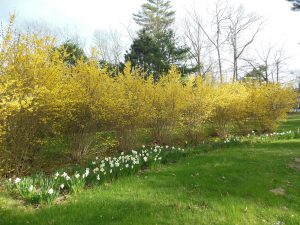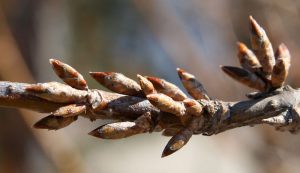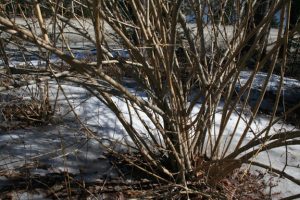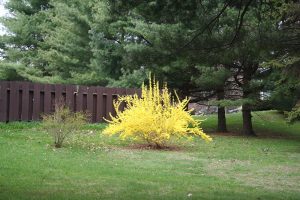Bulletin #2513, Pruning Forsythias in Maine
By Marjorie Peronto, Extension Educator, University of Maine Cooperative Extension
For information about UMaine Extension programs and resources, visit extension.umaine.edu.
Find more of our publications and books at extension.umaine.edu/publications/.
 The bright yellows of forsythia shrubs (Forsythia x intermedia) are a hallmark of spring. They take many forms, from the wild and woolly hedges that haven’t been pruned for decades to the tortured forms that have been sheared to resemble large meatballs, hot air balloons, or flat-topped landscape sculptures.
The bright yellows of forsythia shrubs (Forsythia x intermedia) are a hallmark of spring. They take many forms, from the wild and woolly hedges that haven’t been pruned for decades to the tortured forms that have been sheared to resemble large meatballs, hot air balloons, or flat-topped landscape sculptures.
The most attractive forsythias are those managed to enhance their natural growth habit–slender branches that grow upward and outward, stiffly arching down to earth under the weight of spring flowers. This can be accomplished with a single plant, a small grouping, or a long informal hedge by following the pruning approach described below.
General Culture
Forsythias grow best in full sun — at least six hours of sunlight each day — and well-drained soil that is annually mulched with organic material such as composted manure. This annual mulching will provide all of the fertilizer necessary for optimum growth.
Cultivated Varieties of Forsythia

Development of cultivated varieties (cultivars) of forsythia has focused on three characteristics: flower color (shade of yellow), floral bud cold hardiness, and growth habit. Keep these three criteria in mind when you visit your local garden center or nursery, asking appropriate questions to make sure you choose the best varieties for your site.
All forsythias have yellow flowers, with cultivars varying from soft yellow to intense gold. Growth habits vary from shrubs that reach 10 feet in height and width to dwarf and compact forms more suited to the small garden. Floral bud hardiness varies as well. In areas where winter temperatures reach -30°F (parts of zone 3), gardeners should select a hardy cultivar such as Northern Sun, Northern Gold, Vermont Sun, or Meadowlark.
Annual Pruning
Forsythias have a naturally graceful fountain-like growth habit, but they can be their own worst enemy. Left unpruned, they will become very large, dense, and unruly, with only a few slender flowering branches twisting into the light from a tangle of old woody stems.
By doing some maintenance pruning each year, you help keep the plant in bounds, keep it open and airy, and enhance the proportion of young, flower-bearing branches.
When to Prune Your Forsythia

Forsythias start developing next year’s flower buds in early- to mid-summer, on one-year-old wood. They retain these flower buds through the fall and winter, to burst open the following spring. Shrubs that bloom in the early spring are usually pruned just after they finish blooming. If we prune forsythia in the late winter, while it is still dormant, we remove branches that have pre-formed flower buds, reducing the upcoming spring flower display.
However, when the shrub is severely overgrown, its flower display is not what it could be. As branches age, their flowering potential is reduced. If you find yourself confronted with an old forsythia that has not been pruned in years, consider pruning it while it is still dormant. Pruning during dormancy is easier because you can clearly see how the branches grow in relation to one another.
How to Prune Your Forsythia
1. When pruning a mature forsythia, start by selectively removing one-fourth of the oldest stems. These stems will have the largest basal diameter. As stems thicken with age, they rub against one another in the interior of the shrub, creating wounds. Strategically remove stems to eliminate this rubbing. The oldest, thickest stems are also the tallest, so by removing these, you reduce the height of the shrub without changing its natural form.
Use a pair of loppers or a small, fine-toothed hand saw to remove these large stems. Make most of your cuts as close to the ground as possible. Cut a few back to several inches above the ground, varying the height of the cuts to maintain a natural form. New shoots will emerge from these shortened stems. These shoots will grow vigorously during their first year and should flower profusely in their second and third years.
- Before pruning.
- After pruning.
2. Next, thin out congested branches in the canopy. This type of thinning is done by cutting a branch off at its point of origin on a main stem. This method is the least conspicuous of all types of pruning and maintains the plant’s natural growth habit.
While thinning the canopy, identify and remove:
- any dead, damaged, or diseased branches,
- branches that are growing inward, towards the center of the plant,
- branches that are crossing or rubbing other branches, and
- some of the tallest vigorously upright shoots.

This work should be done with hand pruners or loppers, depending on branch diameter. Make each cut right above the branch collar (the ring of wrinkled bark where a branch originates from a larger stem). Continue thinning branches out until you have created an open, airy plant canopy. You should be able to toss a softball easily through the shrub when you’re done pruning. The open habit will allow light into the center of the shrub, stimulating sturdy new shoots to emerge from the crown and remaining stems.
Resist the urge to shear off the top of your forsythia with hedge clippers. Shearing may be faster, but branches will respond by putting out excessive, dense brushy growth at the stem tips, giving it a very unnatural look.
Wherever you find forsythias pruned to highlight their graceful habit, their upright-arching stems festooned with bright yellow flowers, they serve as lovely harbingers of the new garden year.
Information in this publication is provided purely for educational purposes. No responsibility is assumed for any problems associated with the use of products or services mentioned. No endorsement of products or companies is intended, nor is criticism of unnamed products or companies implied.
© 2015
Call 800.287.0274 (in Maine), or 207.581.3188, for information on publications and program offerings from University of Maine Cooperative Extension, or visit extension.umaine.edu.
The University of Maine is an EEO/AA employer, and does not discriminate on the grounds of race, color, religion, sex, sexual orientation, transgender status, gender expression, national origin, citizenship status, age, disability, genetic information or veteran’s status in employment, education, and all other programs and activities. The following person has been designated to handle inquiries regarding non-discrimination policies: Sarah E. Harebo, Director of Equal Opportunity, 101 North Stevens Hall, University of Maine, Orono, ME 04469-5754, 207.581.1226, TTY 711 (Maine Relay System).





